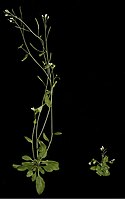
Photo from wikipedia
Heavy rainfall causes flooding of natural ecosystems as well as farmland, negatively affecting plant performance. While the responses of the wild model organism Arabidopsis thaliana to such stress conditions is… Click to show full abstract
Heavy rainfall causes flooding of natural ecosystems as well as farmland, negatively affecting plant performance. While the responses of the wild model organism Arabidopsis thaliana to such stress conditions is well understood, little is known about the responses of its relative, the important oil crop plant Brassica napus. For the first time, we analyzed the molecular response of B. napus seedlings to full submergence in a natural light-dark cycle. We used two cultivars in this study, a European hybrid cultivar and an Asian flood tolerant cultivar. Despite their genomic differences, those genotypes showed no major differences in their responses to submergence. The molecular responses to submergence included the induction of defense- and hormone-related pathways and the repression of biosynthetic processes. Furthermore, RNAseq revealed a strong carbohydrate-starvation response under submergence in daylight, which corresponded with a fast depletion of sugars. Consequently, both B. napus cultivars exhibited a strong growth repression under water, but there was no indication of a low-oxygen response. The ability of the European hybrid cultivar to form a short-lived leaf gas film neither increased underwater net photosynthesis, underwater dark respiration nor growth during submergence. Due to the high sensitivity of both cultivars, the analysis of other cultivars or related species with higher submergence tolerance is required in order to improve flood tolerance of this crop species. One major target could be the improvement of underwater photosynthesis efficiency in order to enhance submergence survival. This article is protected by copyright. All rights reserved.
Journal Title: Physiologia plantarum
Year Published: 2020
Link to full text (if available)
Share on Social Media: Sign Up to like & get
recommendations!